A Modeling Technique for High-Efficiency Battery Packs in Battery-Powered Railway System
Abstract
1. Introduction
2. Theoretical Analysis and Design Considerations
2.1. Analysis of Methods for Terminal Connection
2.1.1. Single Connection Method
2.1.2. Center Connection Method
2.1.3. Diagonal Connection Method
2.2. Analysis of Temperature Effect
2.3. Cell to Cell Connection Topology
2.4. Proposed Module Configuration
3. Experimental Methods and Results
3.1. Simulation Environment Setup and Validation
3.2. Validation of Proposed Model
4. Conclusions
Author Contributions
Funding
Data Availability Statement
Conflicts of Interest
References
- Cheng, V.S.; Li, G.-J. Policy on Carbon Reduction. In Decarbonization of Cities in Asia; Springer: Singapore, 2023; pp. 49–96. [Google Scholar] [CrossRef]
- Li, Y.; Chen, M. Lithium-Ion Batteries. In Towards Next Generation Energy Storage Technologies; Wiley: Hoboken, NJ, USA, 2024; pp. 31–54. [Google Scholar] [CrossRef]
- Tosun, E.; Keyinci, S.; Yakaryılmaz, A.C.; Yıldızhan, Ş.; Özcanlı, M. Evaluation of Lithium-Ion Batteries in Electric Vehicles. Int. J. Automot. Sci. Technol. 2024, 8, 332–340. [Google Scholar] [CrossRef]
- Lal, A.; You, F. Will Reshoring Manufacturing of Advanced Electric Vehicle Battery Support Renewable Energy Transition and Climate Targets? Sci. Adv. 2023, 9, adg6740. [Google Scholar] [CrossRef] [PubMed]
- Quinteros-Condoretty, A.R.; Golroudbary, S.R.; Albareda, L.; Barbiellini, B.; Soyer, A. Impact of Circular Design of Lithium-Ion Batteries on Supply of Lithium for Electric Cars towards a Sustainable Mobility and Energy Transition. Procedia CIRP 2021, 100, 73–78. [Google Scholar] [CrossRef]
- Liu, X.; Li, K. Energy Storage Devices in Electrified Railway Systems: A Review. Transp. Saf. Environ. 2020, 2, 183–201. [Google Scholar] [CrossRef]
- Mitrofanov, S.V.; Kiryanova, N.G.; Gorlova, A.M. Stationary Hybrid Renewable Energy Systems for Railway Electrification: A Review. Energies 2021, 14, 5946. [Google Scholar] [CrossRef]
- Kljaić, Z.; Pavković, D.; Cipek, M.; Trstenjak, M.; Mlinarić, T.J.; Nikšić, M. An Overview of Current Challenges and Emerging Technologies to Facilitate Increased Energy Efficiency, Safety, and Sustainability of Railway Transport. Future Internet 2023, 15, 347. [Google Scholar] [CrossRef]
- Weiss, H.; Winkler, T.; Ziegerhofer, H. Large Lithium-Ion Battery-Powered Electric Vehicles—From Idea to Reality. In Proceedings of the 2018 ELEKTRO Conference, Mikulov, Czech Republic, 21–23 May 2018; IEEE: New York, NY, USA, 2018. [Google Scholar] [CrossRef]
- Brand, M.J.; Hofmann, M.H.; Steinhardt, M.; Schuster, S.F.; Jossen, A. Current Distribution within Parallel-Connected Battery Cells. J. Power Sources 2016, 334, 202–212. [Google Scholar] [CrossRef]
- Schindler, M.; Durdel, A.; Sturm, J.; Jocher, P.; Jossen, A. On the Impact of Internal Cross-Linking and Connection Properties on the Current Distribution in Lithium-Ion Battery Modules. J. Electrochem. Soc. 2020, 167, 120542. [Google Scholar] [CrossRef]
- Park, S.-J.; Song, Y.-W.; Kang, B.-S.; Kim, W.-J.; Choi, Y.-J.; Kim, C.; Hong, Y.-S. Depth of Discharge Characteristics and Control Strategy to Optimize Electric Vehicle Battery Life. J. Energy Storage 2023, 59, 106477. [Google Scholar] [CrossRef]
- Yüksek, G.; Alkaya, A. Effect of the Depth of Discharge and C-Rate on Battery Degradation and Cycle Life. In Proceedings of the 2023 14th International Conference on Electrical and Electronics Engineering (ELECO), Bursa, Turkey, 30 November–2 December 2023; pp. 1–5. [Google Scholar] [CrossRef]
- Wang, L.; Cheng, Y.; Zhao, X. Influence of Connecting Plate Resistance upon LiFePO4 Battery Performance. Appl. Energy 2015, 147, 353–360. [Google Scholar] [CrossRef]
- Zhang, H.; Zhang, Y.; Huang, L.; Song, J.; Huang, Z. Study on the Influence of Connection Structure Between Batteries on Battery Pack Performance. Electronics 2024, 13, 817. [Google Scholar] [CrossRef]
- Kim, K.; Choi, J.-I. Effect of Cell-to-Cell Variation and Module Configuration on the Performance of Lithium-Ion Battery Systems. Appl. Energy 2023, 352, 121888. [Google Scholar] [CrossRef]
- Yang, N.; Zhang, X.; Li, G.; Cai, A.; Xu, Y. Effects of Temperature Differences Among Cells on the Discharging Characteristics of Lithium-Ion Battery Packs with Series/Parallel Configurations during Constant Power Discharge. Energy Technol. 2018, 6, 1067–1079. [Google Scholar] [CrossRef]
- Tran, M.-K.; Mathew, M.; Janhunen, S.; Panchal, S.; Raahemifar, K.; Fraser, R.; Fowler, M. A Comprehensive Equivalent Circuit Model for Lithium-Ion Batteries, Incorporating the Effects of State of Health, State of Charge, and Temperature on Model Parameters. J. Energy Storage 2021, 43, 103252. [Google Scholar] [CrossRef]
- Barcellona, S.; Colnago, S.; Dotelli, G.; Latorrata, S.; Piegari, L. Aging Effect on the Variation of Li-Ion Battery Resistance as Function of Temperature and State of Charge. J. Energy Storage 2022, 50, 104658. [Google Scholar] [CrossRef]
- Al-Hallaj, S.; Selman, J.R. Thermal Modeling of Secondary Lithium Batteries for Electric Vehicle/Hybrid Electric Vehicle Applications. J. Power Sources 2002, 110, 341–348. [Google Scholar] [CrossRef]
- Wang, B.; Ji, C.; Wang, S.; Sun, J.; Pan, S.; Wang, D.; Liang, C. Study of Non-Uniform Temperature and Discharging Distribution for Lithium-Ion Battery Modules in Series and Parallel Connection. Appl. Therm. Eng. 2020, 168, 114831. [Google Scholar] [CrossRef]
- Kang, D.; Lee, P.-Y.; Yoo, K.; Kim, J. Internal Thermal Network Model-Based Inner Temperature Distribution of High-Power Lithium-Ion Battery Packs with Different Shapes for Thermal Management. J. Energy Storage 2020, 27, 101017. [Google Scholar] [CrossRef]
- Hamisi, C.M.; Gerutu, G.B.; Greyson, K.A.; Chombo, P.V. Thermal Behavior of Lithium-Ion Battery under Variation of Convective Heat Transfer Coefficients, Surrounding Temperatures, and Charging Currents. J. Loss Prev. Process Ind. 2022, 80, 104922. [Google Scholar] [CrossRef]
- Korea Railroad Research Institute. Commercialization of Catenary-Free Low-Floor Tram: Final Report on Railway Technology Research Project; Ministry of Land, Infrastructure and Transport; Report No.: 11-1613000-001809-01; Korea Railroad Research Institute: Sejong, Republic of Korea, 2017. [Google Scholar]
- Chang, L.; Duan, B.; Li, P.; Zhang, K.; Zhang, C.; Xiao, L. Influence of Interconnect Resistances on Parallel-Connected LiFePO4 Cells Performance. In Proceedings of the 2019 3rd Conference on Vehicle Control and Intelligence (CVCI), Hefei, China, 21–22 September 2019; pp. 1–4. [Google Scholar] [CrossRef]
- Li, C.; Cui, N.; Chang, L.; Cui, Z.; Yuan, H.; Zhang, C. Effect of Parallel Connection Topology on Air-Cooled Lithium-Ion Battery Module: Inconsistency Analysis and Comprehensive Evaluation. Appl. Energy 2022, 313, 118758. [Google Scholar] [CrossRef]
- Hulett, J.R. Deviations from the Arrhenius Equation. Q. Rev. Chem. Soc. 1964, 18, 227. [Google Scholar] [CrossRef]
- Kucinskis, G.; Bozorgchenani, M.; Feinauer, M.; Kasper, M.; Wohlfahrt-Mehrens, M.; Waldmann, T. Arrhenius Plots for Li-Ion Battery Ageing as a Function of Temperature, C-Rate, and Ageing State–An Experimental Study. J. Power Sources 2022, 549, 232129. [Google Scholar] [CrossRef]
- Luan, C.; Ma, C.; Wang, C.; Chang, L.; Xiao, L.; Yu, Z.; Li, H. Influence of the Connection Topology on the Performance of Lithium-Ion Battery Pack under Cell-to-Cell Parameters Variations. J. Energy Storage 2021, 41, 102896. [Google Scholar] [CrossRef]
- Feng, F.; Hu, X.; Hu, L.; Hu, F.; Li, Y.; Zhang, L. Propagation Mechanisms and Diagnosis of Parameter Inconsistency within Li-Ion Battery Packs. Renew. Sustain. Energy Rev. 2019, 112, 102–113. [Google Scholar] [CrossRef]
- Keyoonwong, W.; Mesakhun, K.; Intanil, K.; Siriwilawan, N.; Chipchukiad, T. Estimating Surface Temperature Profile of Li-Ion Battery Under Several Conditions. In Proceedings of the 2024 10th International Conference on Engineering, Applied Sciences, and Technology (ICEAST), Luang Prabang, Laos, 1–4 May 2024; pp. 37–40. [Google Scholar] [CrossRef]
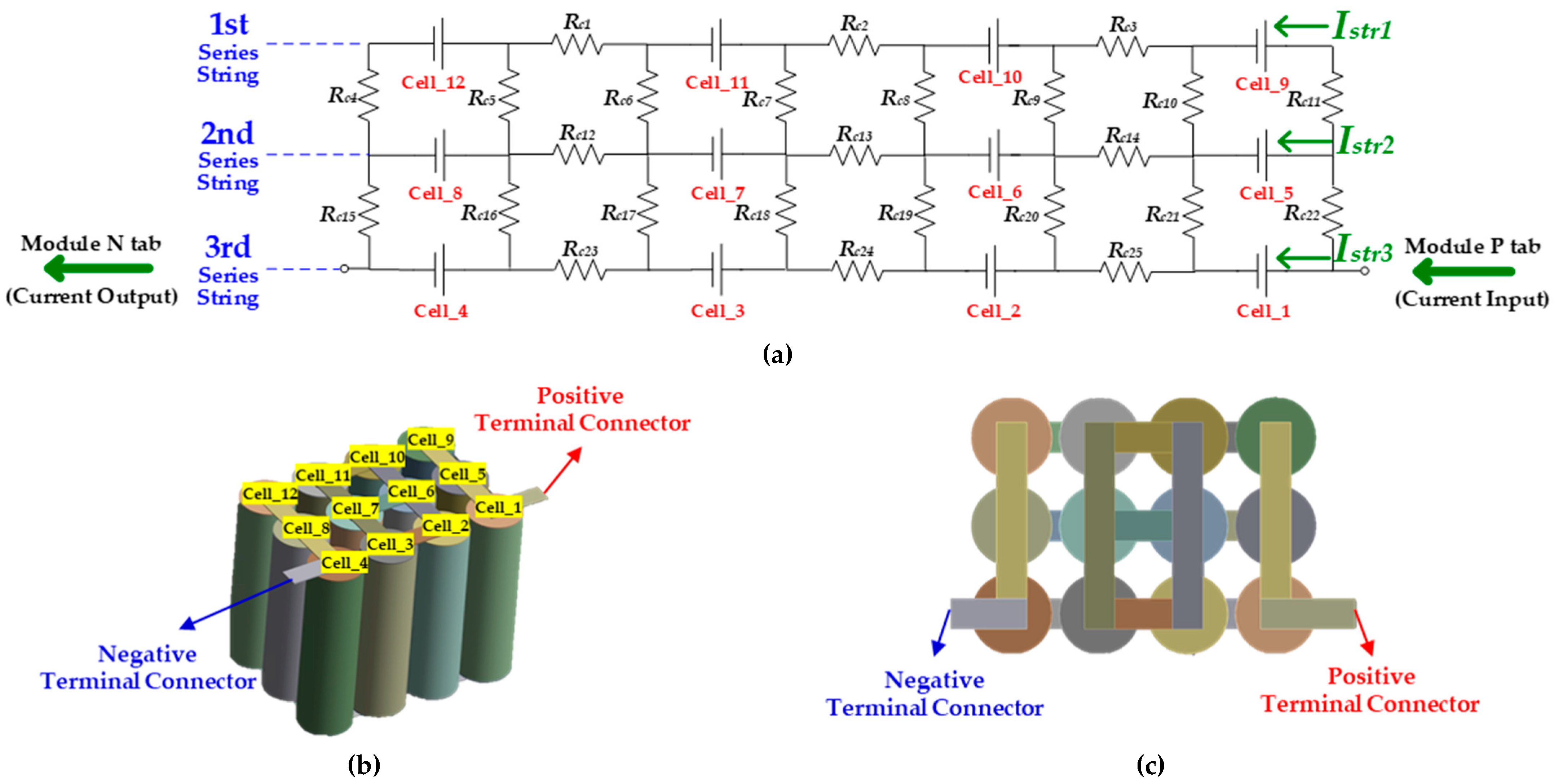

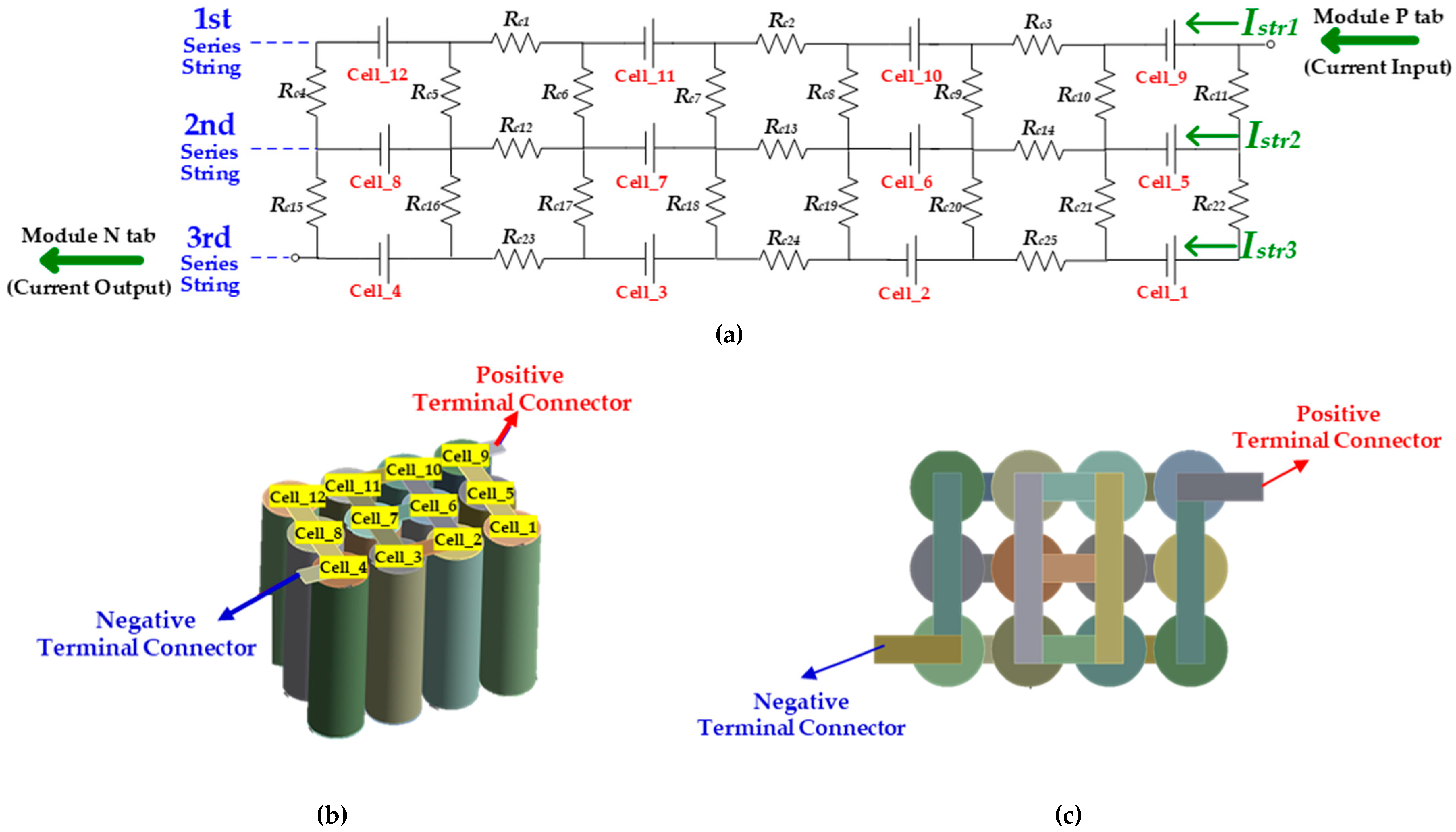
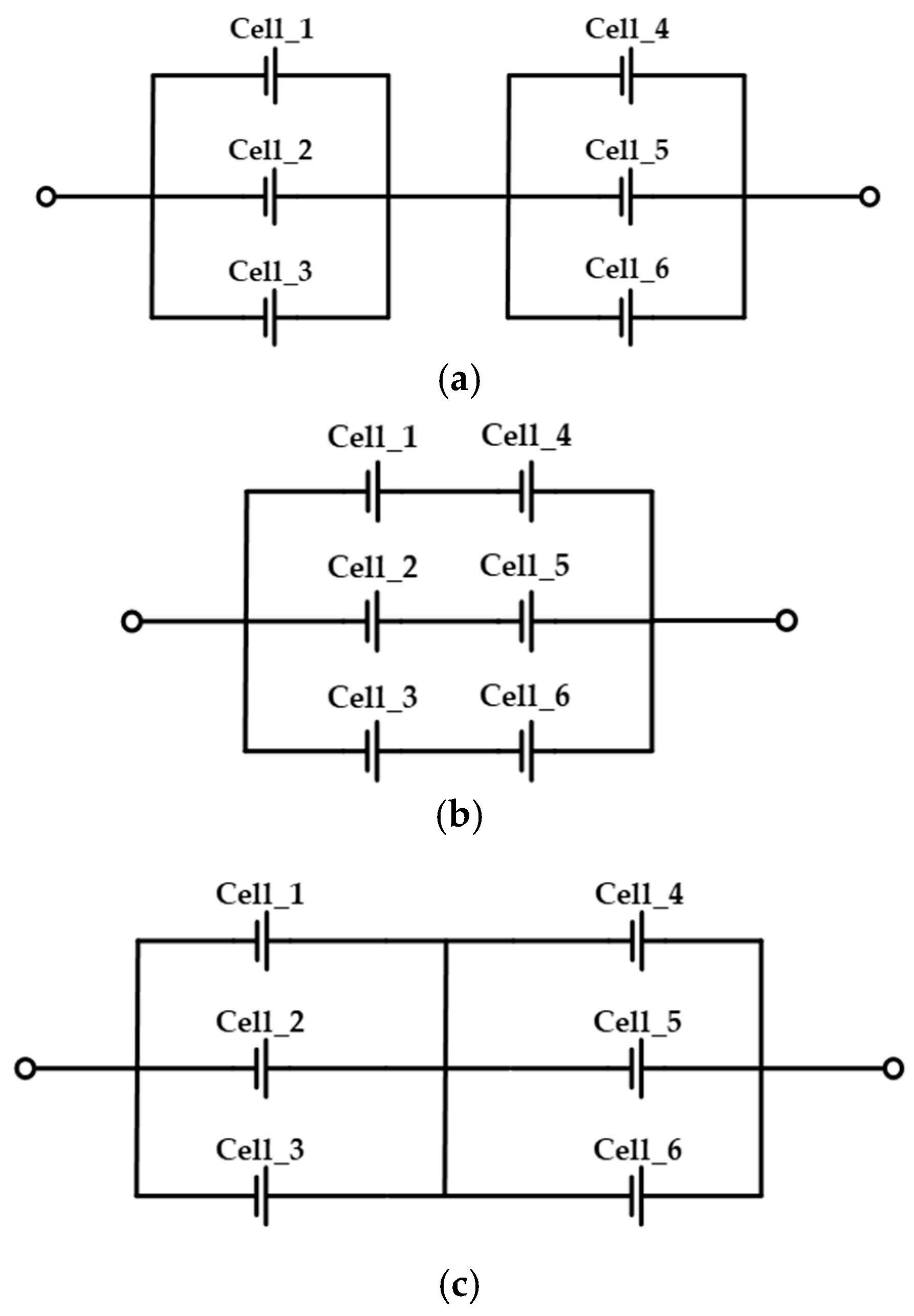




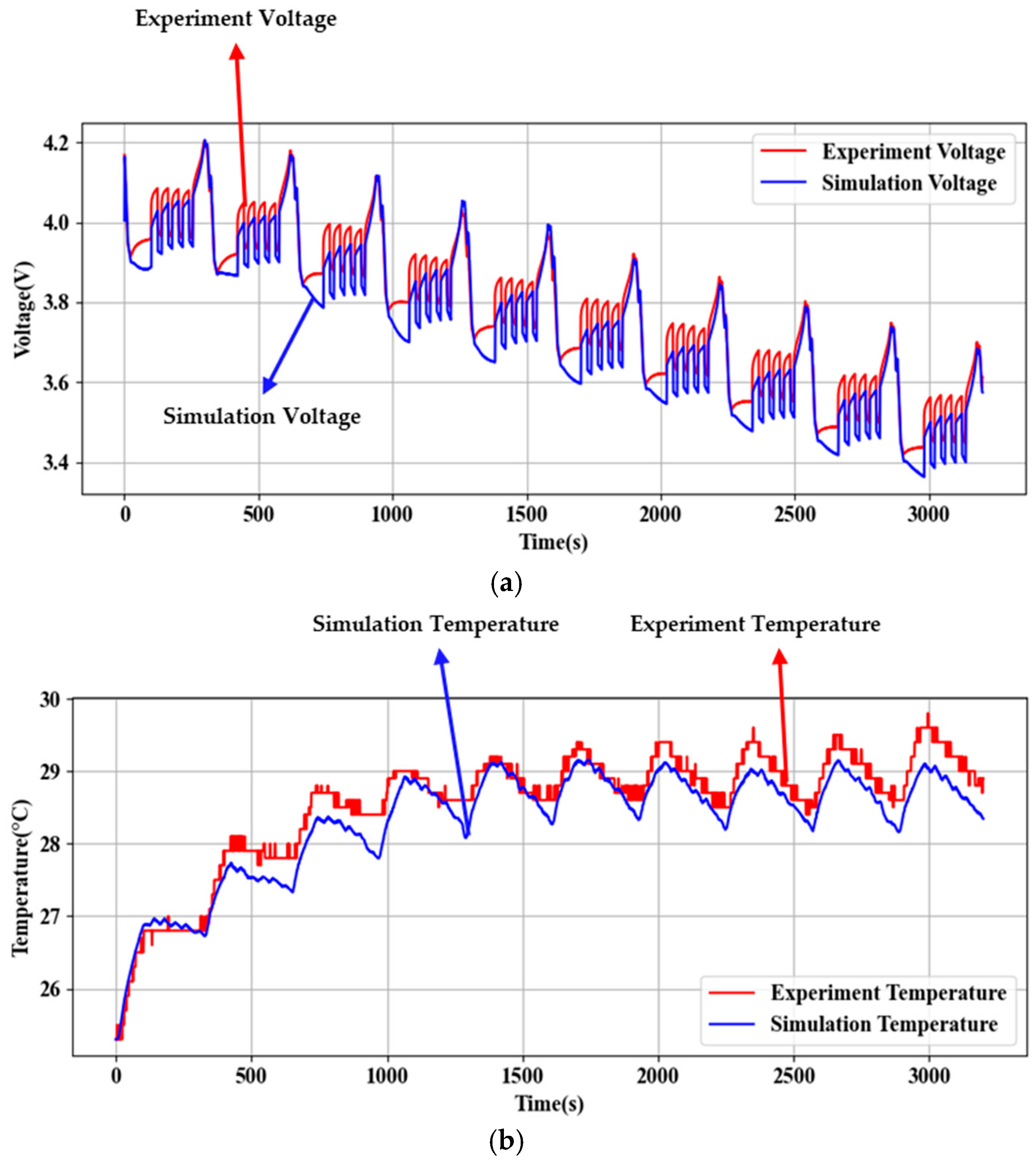
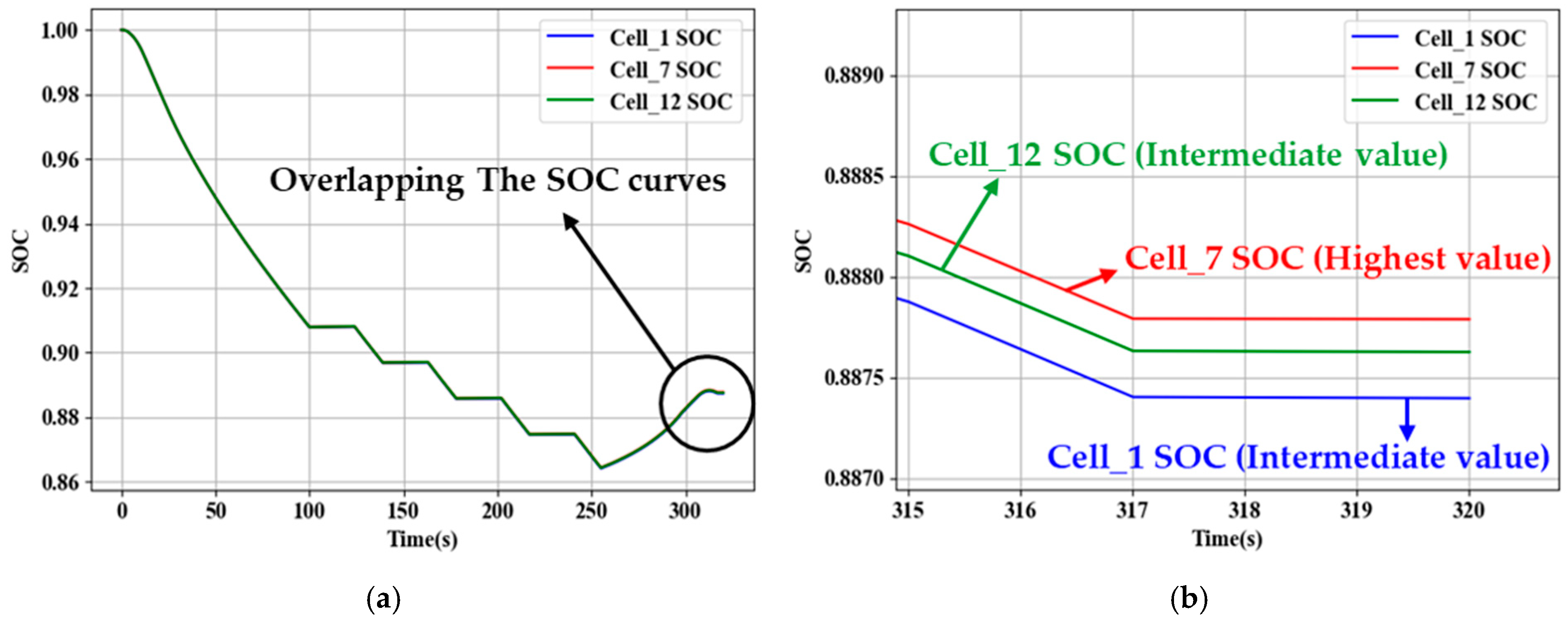
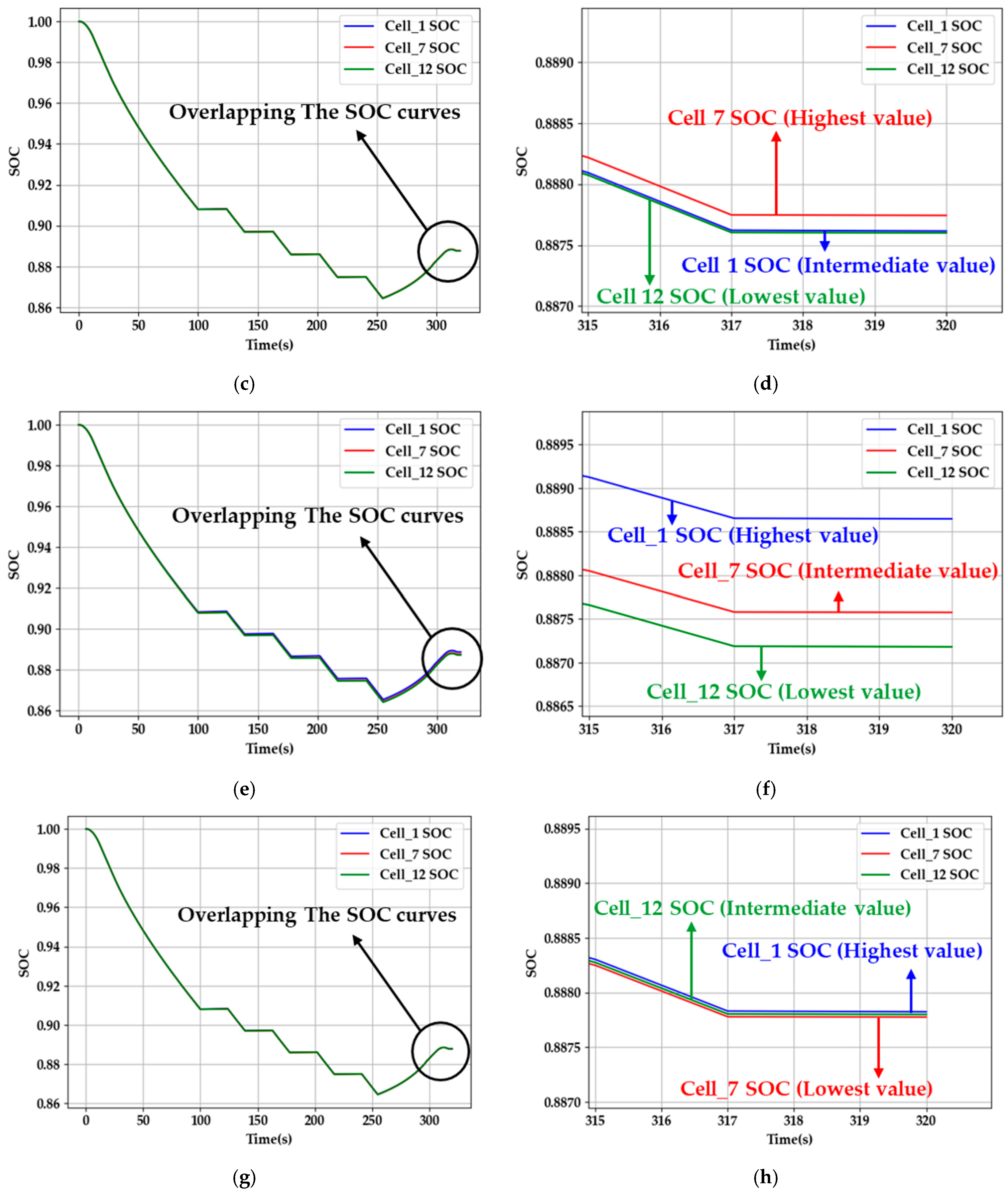
| Samsung SDI | ||
|---|---|---|
| Model | INR21700 40T | |
| Nominal Capacity | 4 Ah | |
| Cathode | NCA | |
| Anode | Graphite + SCN | |
| Nominal Voltage | 3.6 V | |
| Maximum Charging Voltage | 4.2 V (2000 mA Standard) | |
| Minimum Discharge Voltage | 2.5 V | |
| (800 mA Standard) | ||
| Physical Properties | ) | |
| Specific Heat Capacity ) | ||
| Thermal Conductivity (k) | ) | |
| Value | ||
|---|---|---|
| Chamber (LCH-11G-2C, Jeio-TECH, Daejeon, Republic of Korea) | Width (mm) | 600 |
| Depth (mm) | 500 | |
| Height (mm) | 200 | |
| Setting Temperature | 25 °C | |
| Battery Cycler (CT-4008T, Neware, Shenzhen, China) | Resolution | 16 Bit |
| Accuracy | ||
| Thermocouple (CA-4008n, Neware, Shenzhen, China) | Resolution | 16 Bit |
| Measurement Deviation | ||
| Connecting Method | Maximum SOC Deviation | Cell_1 | Cell_7 | Cell_12 |
|---|---|---|---|---|
| Single Connection | 0.00039 | 0.8873 | 0.8877 | 0.8876 |
| Center Connection | 0.00014 | 0.8876 | 0.8877 | 0.8876 |
| Diagonal Connection | 0.00146 | 0.8886 | 0.8875 | 0.8871 |
| Proposal Connection | 0.00004 | 0.8878 | 0.8877 | 0.8877 |
Disclaimer/Publisher’s Note: The statements, opinions and data contained in all publications are solely those of the individual author(s) and contributor(s) and not of MDPI and/or the editor(s). MDPI and/or the editor(s) disclaim responsibility for any injury to people or property resulting from any ideas, methods, instructions or products referred to in the content. |
© 2025 by the authors. Licensee MDPI, Basel, Switzerland. This article is an open access article distributed under the terms and conditions of the Creative Commons Attribution (CC BY) license (https://creativecommons.org/licenses/by/4.0/).
Share and Cite
Sim, J.-U.; Kim, S.-W.; Cho, I.-H. A Modeling Technique for High-Efficiency Battery Packs in Battery-Powered Railway System. Energies 2025, 18, 1272. https://doi.org/10.3390/en18051272
Sim J-U, Kim S-W, Cho I-H. A Modeling Technique for High-Efficiency Battery Packs in Battery-Powered Railway System. Energies. 2025; 18(5):1272. https://doi.org/10.3390/en18051272
Chicago/Turabian StyleSim, Jae-Uk, Seon-Woong Kim, and In-Ho Cho. 2025. "A Modeling Technique for High-Efficiency Battery Packs in Battery-Powered Railway System" Energies 18, no. 5: 1272. https://doi.org/10.3390/en18051272
APA StyleSim, J.-U., Kim, S.-W., & Cho, I.-H. (2025). A Modeling Technique for High-Efficiency Battery Packs in Battery-Powered Railway System. Energies, 18(5), 1272. https://doi.org/10.3390/en18051272







